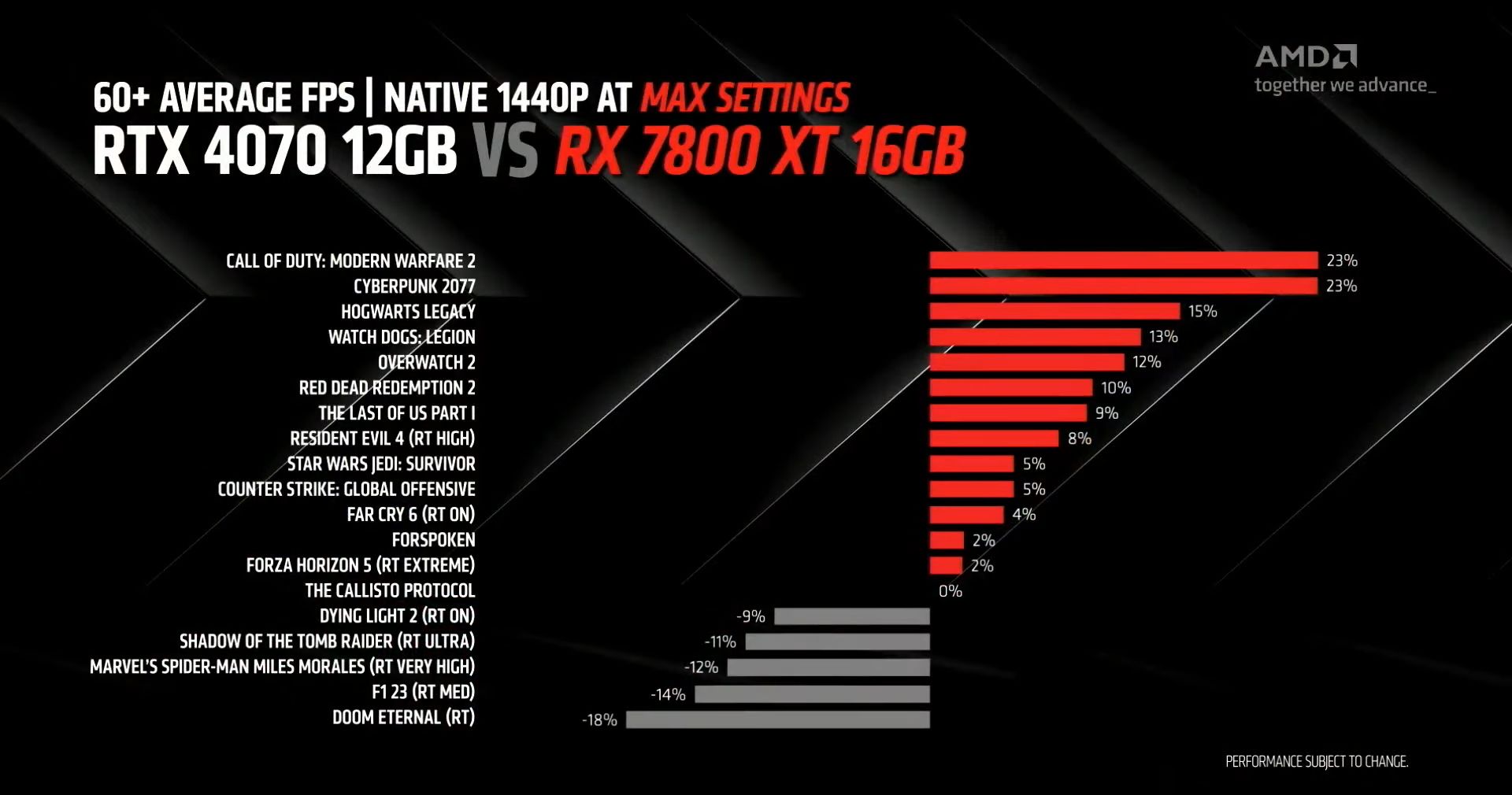
Insights Into AMD's Radeon XT Series: 7800, 7700

Insights Into AMD’s Radeon XT Series: 7800, 7700
Disclaimer: This post includes affiliate links
If you click on a link and make a purchase, I may receive a commission at no extra cost to you.
Key Takeaways
- At Gamescom 2023, AMD announced the highly anticipated Radeon RX 7800 XT and RX 7700 XT, filling a gap in its RDNA 3 GPU lineup.
- Both GPUs are designed for 1440p gaming at 60+ FPS and compete directly with Nvidia’s GeForce RTX 4070 and RTX 4060 Ti.
- The RX 7800 XT and RX 7700 XT have similar configurations but differ in terms of CUs, memory capacity, and clock speeds. They feature the latest RDNA 3 features and connectivity options, but miss out on the USB-C Virtual Link connector.
At Gamescom 2023, AMD officially announced the much-anticipated Radeon RX 7800 XT and RX 7700 XT, filling a significant gap in its RDNA 3 GPU lineup. These graphics cards are designed to deliver a solid 1440p gaming experience at 60+ FPS (even in the most demanding AAA titles) while also competing directly with Nvidia’s GeForce RTX 4070 and RTX 4060 Ti.
To better understand the capabilities of AMD’s current-gen GPU architecture, here’s a comprehensive breakdown of all the relevant details surrounding the RX 7800 XT and RX 7700 XT.
RX 7800 XT vs. RX 7700 XT: Specifications and Overview
For starters, both the Radeon RX 7800 XT and RX 7700 XT are built around AMD’s brand-new Navi 32 GPU die, which adopts a chiplet-based design to reduce manufacturing costs and facilitate production. Like before, the central section of this GPU features a relatively smaller GCD (Graphics Compute Die) than Navi 31 (fabricated on TSMC’s N5 process), flanked by four MCDs (Memory Complex Die) utilizing an older yet efficient N6 technology.
Consequently, AMD’s Radeon RX 7800 XT and RX 7700 XT share a similar configuration with the flagship RX 7900 Series (we’ve previously comparedRX 7900 XTX vs. RX 7900 XT ), as opposed to thebudget-oriented RX 7600 , which employs a monolithic Navi 33 die. On paper, the RX 7800 XT benefits from a fully unlocked Navi 32 GPU, incorporating 60 CUs (or 3,840 Stream Processors), 120 AI accelerators, 64MB of Infinity Cache, and 16GB of GDDR6 memory (clocked at 19.5Gbps) over a 256-bit memory bus.
Meanwhile, the RX 7700 XT uses a cut-down version of the same GPU die with three active MCDs, housing 54 CUs (or 3,456 cores), 108 AI accelerators, 48MB of Infinity Cache, and 12GB of GDDR6 memory (on a narrower 192-bit memory bus) clocked at around 18Gbps. Owing to these adjustments, the RX 7700 XT prioritizes slightly higher clock speeds than the RX 7800 XT, registering an average Game Clock of 2,171MHz and a maximum Boost Clock of 2,544MHz.
Regarding power consumption, both GPUs from AMD remain comparable across the board, with the RX 7700 XT officially rated at 245W, whilst the RX 7800 XT exhibits a marginal increase in its TBP of about 18W. Despite the RDNA 3 microarchitecture’s generational improvement, Team Red’s upcoming duo still suffers from an inferior power profile compared to Nvidia’s AD104 and AD106 silicon.
Aside from the differences in compute performance, memory subsystem, power consumption, and core frequencies, the Radeon RX 7800 XT and RX 7700 XT take advantage of all the latest and greatest features associated with the RDNA 3 microarchitecture. Both variants offer native support for the newDisplayPort 2.1 standard , AV1 encoding and decoding, along with other proprietary technologies from Team Red, including Radeon Super Resolution, Radeon Anti-Lag, and many more.
Moving on to the connectivity front, AMD’s port configuration for the RX 7800 XT and RX 7700 XT misses out on the highly convenient USB-C Virtual Link connector, as seen previously in the RX 7900 Series. While providing a maximum of four video outputs, the upcoming models will include three DisplayPort 2.1 UHBR13.5 ports (at data rates up to 54Gbps) alongside a single HDMI 2.1 connector.
| Specifications | RX 7800 XT | RX 7700 XT |
|---|---|---|
| GPU Architecture | Navi 32 | Navi 32 |
| Process Node | TSMC N5/N6 FinFET | TSMC N5/N6 FinFET |
| Compute Units | 60 | 54 |
| Stream Processors | 3,840 | 3,456 |
| AI Accelerators | 120 | 108 |
| RT Accelerators | 60 (2nd Gen) | 54 (2nd Gen) |
| Game Clock | 2,124MHz | 2,171MHz |
| Boost Clock | Up to 2,430MHz | Up to 2,544MHz |
| Memory Interface | 256-bit | 192-bit |
| Memory Capacity | 16GB GDDR6 | 12GB GDDR6 |
| Memory Speed | 19.5Gbps | 18Gbps |
| Memory Bandwidth | 624GB/s | 432GB/s |
| Infinity Cache | 64MB | 48MB |
| TMUs | 240 | 216 |
| FP32 (Single Precision) Performance | 37.32 TFLOPS | 35.17 TFLOPS |
| FP16 (Half Precision) Performance | 74.65 TFLOPS | 70.34 TFLOPS |
| TBP | 263W | 245W |
The specifications alone show that the RX 7800 XT is a logical replacement for the RX 6800 rather than its direct predecessor—the RX 6800 XT. Given how closely the CU count aligns between both GPUs, a straightforward contender for the RX 6800 XT happens to be AMD’s China-exclusive Radeon RX 7900 GRE (Golden Rabbit Edition), which packs a total of 80 compute units and is currently priced at $649.
On the contrary, the RX 7700 XT presents a compelling upgrade path from the previous-gen RX 6700 XT and its mid-gen refresh—the RX 6750 XT—albeit at a $100 price premium. Nevertheless, it remains to be seen whether AMD has truly delivered a noteworthy generational uplift or inadvertently launched a costly sidegrade like Nvidia’s much-maligned GeForce RTX 4060 Ti.
RX 7800 XT vs. RX 7700 XT: Gaming Performance
According to AMD’s internal benchmarks, the Radeon RX 7800 XT engages in a back-and-forth battle with Nvidia’s $600 RTX 4070, whereas the RX 7700 XT stands favorably against the $500 RTX 4060 Ti 16GB variant. More importantly, both GPUs demonstrate the ability to surpass the 60 FPS threshold at 1440p, “Ultra” settings in a range of recent AAA titles.

Image Credit:IGN
Across the 19-game configuration sample, the RX 7700 XT outperforms Nvidia’s GeForce RTX 4060 Ti 16GB by about 12% on average. Interestingly, AMD’s scaled-down Navi 32 GPU secures a 17% lead in rasterization performance while exhibiting a mere 4% deficit in certain games that implement advanced ray tracing effects.

Image Credit:IGN
Furthermore, AMD’s performance figures for the RX 7800 XT put it in a formidable position against the RTX 4070, showcasing a 9% advantage in rasterization and a 6% deficit in select RT titles. Although the average gain isn’t as impressive as seen in the previous slide, the RX 7800 XT undercuts Nvidia’s upper mid-range offering by around $100.
RX 7800 XT vs. RX 7700 XT: Pricing and Availability
At an MSRP of $499, AMD’s Radeon RX 7800 XT represents a better price-to-performance ratio than the cut-down Navi 32 variant on multiple occasions. If the performance numbers for both GPUs hold true, the RX 7700 XT, at a starting price of $449, could face some potential challenges in its own lineup.
Regardless, AMD’s mid-tier graphics cards are set to hit the market on September 6, 2023. To sweeten the deal further, Team Red will also include a free copy of Bethesda’s long-awaited space RPG, Starfield, with the purchase of these GPUs.
While the Radeon RX 7800 XT comes in an AMD reference dual-fan, dual-slot design, alongside custom variants, the RX 7700 XT will only be made available through AIB partners like ASRock, ASUS, Biostar, Gigabyte, PowerColor, Sapphire, Vastarmor, XFX, and Yeston.
AMD’s Next-Gen 1440p Gaming GPUs Unveiled
From what has been revealed, AMD’s marketing strategy for this launch involves pitting the Radeon RX 7800 XT and RX 7700 XT against older yet capable 1440p cards. Considering the recent adoption of QHD displays, both GPUs should be able to offer a stellar gaming experience, with enough headroom to drive graphically demanding titles at 4K.
Ultimately, the success of these sub-$500 graphics cards will depend largely on their real-world performance, feature set, and overall, given that this market segment is highly competitive.
Also read:
- [New] 2024 Approved The Insider’s Guide to Instagram Video Engagement
- [New] From Humble Beginnings to Sponsored Success Channels' Blueprint
- [New] Into the Virtual Vortex Mastering Techniques of Gameplay Recording
- [Updated] 2024 Approved Secrets of Seamlessly Sharing in TikTok Livestreams
- A New Approach: Assessing Your Priorities Beyond Steam Points
- Deciphering Complete FBM Call Transcripts Guide for 2024
- Enjoy Peaceful Play with Mic-Free PS5
- Every Game Ever - A Universal Dream Achieved
- How to Get and Use Pokemon Go Promo Codes On Google Pixel 8 | Dr.fone
- In 2024, Best 3 Vivo Y100i Power 5G Emulator for Mac to Run Your Wanted Android Apps | Dr.fone
- In 2024, Top 10 Fingerprint Lock Apps to Lock Your OnePlus Nord CE 3 Lite 5G Phone
- In 2024, Which is the Best Fake GPS Joystick App On Samsung Galaxy S24 Ultra? | Dr.fone
- Is LinkedIn's Game Add-On Really Worth Your Time?
- Maximizing Your Librarian Skills: Fixing EG Libraries Problems
- Navigating the Steps to Enhance PS5 Game Access Control
- Revolutionize Your Gaming Setup with EmuDeck & Steam Deck
- The Truth About Being Marked as Inactive by Discord
- Title: Insights Into AMD's Radeon XT Series: 7800, 7700
- Author: William
- Created at : 2024-09-26 02:30:12
- Updated at : 2024-09-26 20:40:12
- Link: https://games-able.techidaily.com/insights-into-amds-radeon-xt-series-7800-7700/
- License: This work is licensed under CC BY-NC-SA 4.0.